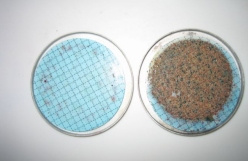A Bio-Sand Filter Technology Primer
Clean water is important.
More than 2.6 billion people around the world do not have regular access to clean drinking water, and waterborne illness is the cause of death of nearly 5,500 people per day, many of them children, according to United Nations research.
Bio-Sand Filter technology is simple.
Filters are made of concrete poured into a steel mold. A copper pipe runs inside the filter wall where it is not easily damaged from the bottom of the filter to the discharge spout. A filter is about the size of an office water cooler. The container holds about 10 gallons (40-50 liters). Layers of specially selected, sifted and washed sand and gravel are placed inside and a tin splash plate is placed on top of the layers to dissipate the force of the water poured into a filter. A tin lid protects the top of the filter opening.
Bio-Sand Filters are a good idea made better.
Sand filters to purify water have been used for centuries. The Bio-Sand Filter makes several innovative improvements on the traditional “slow sand filter.” The critical innovation is a 2-4 inch (5-10 centimeter) layer of water that remains above the fine sand layer that permits “as-needed” intermittent use and creates a bio-layer of microorganisms. This bio-layer innovation feeds on the pathogens in dirty water, and enhances the effectiveness of the traditional filter to eliminate sediments, bacteria, viruses, compounds, cysts, worms and other impurities. In addition, the Bio-Sand Filter can be produced locally with local materials for low cost, compared to ceramic, plastic or metal containers.
What are the pro’s and con’s of Bio-Sand Filters?
One of the best summaries is provided by CAWST.org, a Canadian organization dedicated to distributing Bio-Sand Filter information worldwide:
Pro’s:
- Removes over 90% bacteria, 100% parasites
- Removes turbidity, some iron, manganese, arsenic and mercury.
- Quality of water improves with time
- Produced for US$10-30.
- High flow rate: 60 liters/hour
- No on-going costs, no replaceable parts
- Durable and robust, virtually lasts forever
- Fabricated from local materials
- Small enough to fit into smallest kitchen
- Opportunity for local businesses
- Water tastes and looks good
- Easy to maintain
Con’s:
- Heavy, difficult to move
- Biological layer takes 1-2 weeks to develop to maturity
- High turbidity (> 100 NTU) will cause filter to clog and require more maintenance
- Requires filter be used periodically on a regular basis
- Cannot remove color or dissolved compounds



